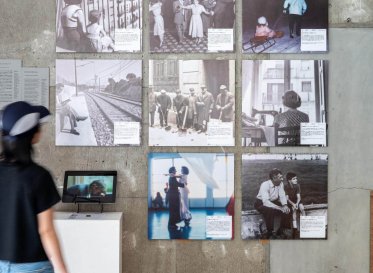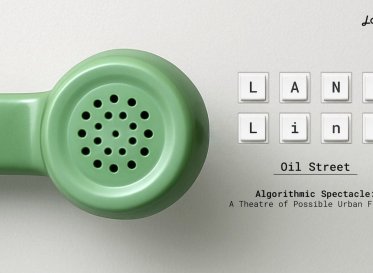Using Augmentation To Understand The World As Seen By Organisms

Promoting Empathy And Co-existence With The Natural World Through Robotics Technology
MTRL, a joint research partner of Panasonic Corporation’s Aug Lab – an open laboratory organization conducting research and development into augmentation – created two works as part of the Umwelt Interface Project to explore and prototype the relationship between people, organisms and interfaces.
UMOZ is a six-legged, moss-covered autonomous robot that moves when it is sprayed with water, created to express the world as moss sees it. UMOZ is equipped with light and humidity sensors and will move towards the direction of sunlight. Powered by a battery, it is characterized by its pet-like responses, such as moving when water is sprayed on it.
MOSS Interface uses moss as an interface for home appliances. It changes the basis of the interface of home appliances from “control” to “symbiosis” so that when water is given to moss, the lighting becomes brighter, and when it dries, the lighting becomes darker.
Both works were developed based on the theme of umwelt – the world as it is experienced by a particular organism presented by the German biologist and philosopher Jakob Johann von Uexküll and are on display at AkeruE in Ariake, Tokyo until the end of September.
*The works are not for sale at the moment


Work Details
UMOZ Imagines The World Of Mosses Through Their Behavior
UMOZ is a six-legged, moss-covered autonomous robot that moves when it is sprayed with water, created to express the world as moss sees it. UMOZ is equipped with light and humidity sensors and will move towards the direction of sunlight. Powered by a battery, it is characterized by its pet-like responses, such as moving when water is sprayed on it.
Mosses perceive light and moisture, and each type of moss takes root in its suitable environment. Mosses have organs called “rhizoid” which help them to take root in the ground. Unlike ordinary plant roots, rhizoids do not absorb nutrients or water, they simply act as legs to establish themselves. As a result, mosses do not need soil like many other plants and can establish themselves on stones or wooden surfaces.
On the other hand, humans live in a modern world where light and humidity are controlled at will, whereas environmental conditions are constantly changing. If moss were to live rationally in such a controlled natural environment, the rhizoids would become an organ for movement rather than rooting.
The extension of the moss’s ability to move would lead to an intelligible perception of its behavior, which would create an opportunity to think about the umwelt of moss and promote empathy for moss and the natural environment.
From "control" to "symbiosis": MOSS Interface
We are surrounded by a variety of interfaces, including switches. The products equipping these interfaces must possess a level of “accuracy”, so that they can accurately reflect the user’s operation. Instead of creating an interface on the basis of “control,” MTRL built the MOSS Interface on the concept of “symbiosis.”
Moss grows by absorbing moisture through its leaves and stems, but each species has a different drying rate and requires a different amount of moisture.
MOSS Interface creates a connection between this attribute and lighting, a key element in the lives of humans to alter the experience of spaces. Just like the suitable level of moisture constantly changes for the moss depending on the season and time of day, users of MOSS Interface have to suitably adjust the moss’ moisture to achieve the desired amount of light. When the moss is watered, the light becomes brighter, and when it is dry, the lights become dimmer.
In order to achieve the ideal lighting environment, the user must take into account today’s climate, their personal mood and balance that with the needs of the moss to decide how much water they should give the interface each day.
Through an interface built on this relationship, MTRL aims to create an opportunity for people to understand the symbiosis between the moss and our surroundings.
About The Umwelt Interface Project
MTRL’s work is based on the theme of umwelt – the world as it is experienced by a particular organism. Proposed by German biologist Jakob Johann von Uexküll (1864-1944) in his book The World from the Viewpoint of Living Things, the concept posits that all organisms construct their own world based on their own perceptions so the world is not an objective environment for living things, but a unique world that each living thing constructs on its own initiative.
The project hypothesized that we can experience the possibility of new symbiosis and enriched life between people and the environment through understanding the umwelt of other organisms. The MTRL team chose to focus on moss, which vary in personality despite being similar in appearance, and created two works – UMOZ and MOSS Interface, with the goal of extending human empathy towards other living things.
Comment from project member Yanagihara

The proposal at the beginning of the project was to studying the umwelt of human beings, but through various discussions with the members of Aug Lab and Loftwork, the subject changed to the natural objects surrounding humans. With members of GADARA, who originally work in private, we went to Kamakura and Hida to observe moss growing in their natural habitat in order to explore their worldview and let that govern the direction of the work. The projects are still in the prototype stage, so I’d like to continue working on brushing them up with the team members. In the same way that we learned the umwelt of moss through the production of this work, I hope that it will change the perspective of anyone who touches this work and help them to gain an interest in nature.
Production Team
Joint Research Promotion

“Aug Lab“, part of the Panasonic Corporation Robotics Promotion Office, is an open lab type organization for the research and development of augmentation as a new value that robotics technology can bring beyond automation.
Collaborative Research Partner

MTRL is a global platform that supports the co-creation of material manufacturers and creators to foster innovation. https://mtrl.com/
Design Support

GADARA is an interaction design unit that explores the relationship between people and technology through experimentally developing physical interactive devices, sensing and musical expression using AI, using “natural fluctuations” as the axis of design. https://gadara.io/
On Display at AkeruE from July 6
“UMOZ” and “MOSS Interface” will be exhibited at AkeruE, the new Panasonic Creative Museum in Ariake, Tokyo, in Spring 2021. The facility provides visitors with the experience of both learning and creating things.
Come experience Aug Lab’s world of Augmentation. Click here for more information.
Exhibition Details
Exhibitors
2020 “Aug Lab” Joint Research Partners
- MTRL
- We+
Venue
AkeruE, a museum turning inspiration into reality
2F, Panasonic Center Tokyo 3-5-1 Ariake, Koto-ku, Tokyo 135-0063
2 minutes walk from Kokusai-Tenjijo Station on the Rinkai Line
3 minutes walk from Ariake Station on the Yurikamome Line
https://www.panasonic.com/jp/corporate/center-tokyo/akerue.html
Project Members
Loftwork Inc., FabCafe MTRL Director
Kazuya Yanagihara
Born in Osaka, Japan, Kazuya Yanagihara joined Loftwork in 2018 and MTRL the following year. After working for an editing company in Osaka, where he produced informational magazines and university brochures, he went to the Graduate School of Media Design at Keio University. After completing his master’s degree, he became involved in the management of the Haptic Design Project as a researcher. Outside of work, he collaborates with his friends from graduate school on a project named “GADARA” focused on the theme of harmony between nature and technology.
Producer, MTRL, Loftwork Corporation / Project Researcher, Graduate School of Media Design, Keio University
Kazuya Ohara (Benkei)
Joining Loftwork in 2015, Ohara, nicknamed Benkei, became involved in the operation of MTRL, a platform aimed at showing the new value of materials, as a founding member. Currently, as a producer, he is involved in planning projects and new business creation for companies based on materials. His motto is “Life is a mismatch”. He is the author of the book “Can Fashion be Renewed? Conference: Dreaming Up Process Innovation for People, Clothes and Society” (Filmart, 2015).
Director, MTRL, Loftwork Inc.
Emi Nagashima
After graduating from Musashino Art University’s Department of Visual Communication Design, Emi Nagashima worked as a director at an advertising company, where she was in charge of creating events and digital content. Through planning exhibitions and experiential advertisements, she became interested in experiential design that involves physicality and joined Loftwork in 2016. Through digital content, she explores the possibilities of holistic design surrounding objects and media. Her hobby is visiting e-commerce sites.
Panasonic Corporation
Aug Lab
In April 2019, Panasonic established the Aug Lab, an organization for research and development of Augmentation and the new value that robotics technology can bring beyond Automation. Aug Lab explores what excites people and their ideal types of well-being through co-creation and prototyping with designers and creators, while researching from non-engineering perspectives.
Director, Robotics Promotion Office, Manufacturing Innovation Division, Panasonic Corporation / Director, Aug Lab
Takeshi Ando
Takeshi Ando, PhD, joined Panasonic in 2011 after faculty member of School of Science and Engineering, Waseda University and Graduate School of Medicine, Osaka University. He is currently the Director of Aug Lab and the Director of the Robotics Promotion Office. He is interested in the relationship between human, society and technology and is involved in all aspects of robotics, from elemental research to business development. He specializes in robotics, human-machine interaction and bioengineering. He is also a member of various committees of the Ministry of Economy, Trade and Industry (METI) and academic societies and has received many awards from the IEEE, the Japan Society of Mechanical Engineers (JSME) and the Robotics Society of Japan.
GADARA, Creator / Freelance Designer
Minatsu Takekoshi
Minatsu Takekoshi is a freelance designer at GADARA, where she creates interaction-related works that explore the relationship between people and technology, using “the fluctuation of nature” as the axis of design. After studying product design at university and interaction design and body cognitive psychology at graduate school, she worked for a company creating installations, researching and developing image processing using deep learning. She is now involved in the design and mechanism of IoT devices and art expression using AI. She is a member of FabCafe Crew OG.
Next Contents








